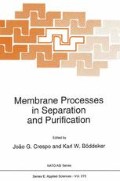Abstract
Due to a strong increase in the world’s population and a continuous growth of industrial productivity the world energy consumption continues to increase. On the other hand, the fossil energy resources such as oil, gas and coal are gradually exhausted. In order to secure the energy supply for the near future energy saving measures should be taken and the development of energy-saving technologies should be stimulated. In this respect membrane technology is an emerging technology with many prospects as an energy saving separation technology. In a number of classical separation techniques such as distillation, evaporation, refrigeration, condensation, a phase change occurs and the energy consumption is relatively high. Membrane technology is one of the new separation techniques with a relatively low energy consumption since no phase change takes place, except for pervaporation.
In this paper the energy aspects of membrane separation processes will be emphasized. First the thermodynamic minimum energy consumption of a separation process will be described and the minimum consumption of various membrane processes will be given. To calculate the actual energy requirements, relations are given for the energy consumption of a mechanical device which applies the driving force, e.g. a pump and a compressor. A classification of the energy consumption of the various membrane processes will be given according to their driving force; pressure driven processes (microfiltration, ultrafiltration, nanofiltration and reverse osmosis), partial pressure driven processes (gas separation, vapour recovery and pervaporation) and electrically driven processes (electrodialysis). Some examples will be given where membrane processes will be compared with competing processes in terms of energy requirements. Finally, hybrid processing, the combination of various separation processes, will be considered as an energy saving option, and some examples will be given.
Access this chapter
Tax calculation will be finalised at checkout
Purchases are for personal use only
Preview
Unable to display preview. Download preview PDF.
References
M. Rudolph and H. Schaeffer, Spektrum der Wissenschaft, October 1982, p. 86.
Brochure of the Dutch Energy Center (ECN), Petten, The Netherlands.
Central Bureau of Statistics in the Netherlands, Energy balances in the Netherlands in 1991.
J.L. Humphrey, A.F. Seibert, and R.A. Koort Separation technologies; Advances and priorities, DOE Report 1991.
J. Woudstra, lecture presented at the NOVEM Mini-symposium on Energy and Membrane Processes, Utrecht, The Netherlands, March, 1993.
M.H.V. Mulder, Basic Principles of Membrane Technology, Kluwer, Dordrecht, The Netherlands, 1991.
H. Strathmann, Electrodialysis, design and cost estimates, in’ Membrane Handbook’, W.S. Ho and K.K. Sirkar (Eds.), Van Nostrand Reinhold, NY, 1992, Chapter 19, p. 245.
R. Glimenius, Microfiltration, State-of-the-art, Desalination 53 (1985) 363.
Membrane Handbook, W.S. Ho and K.K. Sirkar (Eds.), Van Nostrand Reinhold, NY, 1992.
Membrane separation systems, Recent development and future directions, R.W. Baker (Ed.), Noyes Data Corp., Park Ridge, NJ, 1991.
The membrane alternative. Energy implications for industry, Watt Committee Report Number 21, J.A. Howell (Ed), Elsevier, London, 1991.
A. E. Steenbergen, Energy costs down in drying techniques in the dairy (in dutch), I2-Procestechnologie, No. 8 (1991) p.41.
S.L. Matson, W.J. Ward, S.G. Kimura, and W.R. Browall, ‘Membrane oxygen enrichment, II Economic assessment, J. Membr. Sci., 29 (1986) 79.
A. Golland, and M.H. Kleper, Membrane based air separation, AIChE Symp. Ser., No. 250, 82, (1986) 35.
W.J. Koros, Gasseparations, in ‘Membrane separation systems, Recent development and future directions’, R.W. Baker (Ed.), Noyes Data Corp., Park Ridge, NJ, 1991, Chapter 3.
R.W. Spillman, Economics of gas separation processes, Chem. Eng. Progress, Jan. 1989, p. 41.
J. Gmehling and U. Onken, Vapour-liquid equilibrium data collection, aqueous organic systems, Chemistry Data Series, Vol. 1, part 1, Dechema, Frankfut, 1977.
U. Sander, Proceedings of the First Pervaporation Conference, Atlanta, 1986, p. 163.
U. Sander and P. Soukop, Design and operation of a pervaporation plant for ethanol dehydration, J. Membr. Sci., 36 (1988) 463.
J. Neel, Fundamentals of pervaporation for ethanol/water separation, in ‘The membrane alternative. Energy implications for industry’, Watt Committee Report Number 21, J.A. Howell (Ed), Elsevier, London, 1991, Section 8, p. 59.
J.L. Rapin, The Betheniville pervaporation unit- the first large scale production plant for the dehydration of alcohol, Proceedings of the Third International Conference on Pervaporation Processes in the Chemical Industry, R. Bakish, Ed., 1989, 501.
C.S. Robinson, and E.R. Gilliland, Elements of fractional distillation, McGraw Hill, New York, 1950.
J.K. Gienger and R.J. Ray, Membrane-based hybrid processes, AIChE Symp. Series, 261, Vol. 85 (1989) 168.
R.J. Ray, R.W. Witcherley, P. Newbold, S. McCray, D. Friessen and P. Brose, Synergistic, membrane-based hybrid separation systems, J. Membr. Sci., 62 (1991) 347.
R. Rautenbach, C. Herion, and M. Franke, Dehydration of multi-component organic systems, Desalination, 70 (1988) 445.
H.L. Fleming and C. Stewart Slater, Pervaporation, applications and economics, in’ Membrane Handbook’, W.S. Ho and K.K. Sirkar (Eds.), Van Nostrand Reinhold, NY, 1992, Chapter 10, p.132.
A. Dams and J. Krug, Pervaporation aided esterification- Alternatives in plant extension for an existing chemical process, Proceedings of the Fifth International Conference on Pervaporation Processes in the Chemical Industry, R. Bakish, Ed., 1991, 338.
Author information
Authors and Affiliations
Editor information
Editors and Affiliations
Rights and permissions
Copyright information
© 1994 Springer Science+Business Media Dordrecht
About this chapter
Cite this chapter
Mulder, M. (1994). Energy Requirements in Membrane Separation Processes. In: Crespo, J.G., Böddeker, K.W. (eds) Membrane Processes in Separation and Purification. NATO ASI Series, vol 272. Springer, Dordrecht. https://doi.org/10.1007/978-94-015-8340-4_22
Download citation
DOI: https://doi.org/10.1007/978-94-015-8340-4_22
Publisher Name: Springer, Dordrecht
Print ISBN: 978-90-481-4423-5
Online ISBN: 978-94-015-8340-4
eBook Packages: Springer Book Archive

